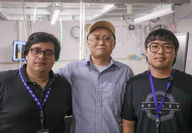Sorted by date Results 1 - 8 of 8

Lithium Nevada receives Department of Defense grant to accelerate the domestic production of battery-grade lithium carbonate. To help meet growing demand for the batteries powering America's energy transition and military hardware, the U.S. Department of Defense has awarded Lithium Nevada Corp., a subsidiary of Lithium Americas Corp., $11.8 million to accelerate the extraction and processing of lithium carbonate at its Thacker Pass mine project in Nevada. "It is critical that...

Refines process toward commercial development with planned advancements and pilot plant. Marking a significant step forward in energy storage technology, Graphene Manufacturing Group Ltd. revealed the latest progress in developing graphene-aluminum-ion batteries, highlighting the company's success in optimizing performance and pushing the boundaries of current battery capabilities. Based out of Australia, GMG has been pioneering advancements in graphene-aluminum battery...

Florida State University scientists study quantum properties of cesium-vanadium-antimonide. In quantum physics, the name Kagome, an ancient design seen in traditional Japanese basket-weaving, has been borrowed by scientists to describe a class of ferromagnetic quantum materials with an atomic structure closely resembling this distinctive lattice pattern. A new Florida State University (FSU) study published in Nature Communications focuses on how a particular Kagome metal...

Based on new simulations, a team of geoscientists suspects Mercury may have a 10-mile-thick layer of diamonds buried beneath its graphite grey surface. While we can't yet go digging to prove it, a new study reveals the likely presence of a layer of diamond nearly ten miles thick at the boundary between Mercury's core and mantle. When viewed by spacecraft from 2011 to 2015, Mercury appeared exceptionally grey due to the high concentrations of graphite, which is pure carbon, on...

Carnegie Science researchers postulate complexity of matter, living or non-living, evolves over time. In a revelation that challenges our understanding of the universe, researchers from Carnegie Science have discovered that minerals may evolve much the same way living organisms do, suggesting that the principles of evolution extend beyond biology, potentially reshaping our perspective on the natural world. This groundbreaking study, published in the journal PNAS Nexus, offers...

Bronze Age firebricks may present an inexpensive solution to energy storage for modern industrial processes. Scientists and early man have something in common when it comes to energy storage: the heat-absorbing bricks used to line primitive kilns and iron-making furnaces thousands of years ago may help store intermittent power from renewables to switch over to green energy sooner – and for a trillion dollars less – according to recent Stanford-led research published in PNA...

Company leverages decades of experience to offer sustainable mining equipment and technologies. With global mining companies focused on minimizing their environmental footprint while maximizing the efficiency and profitability of producing the minerals needed to build a sustainable future, Komatsu will be showcasing its latest electrification solutions at MINExpo 2024 in Las Vegas, Nevada, from Sept. 24 to 26. Put on by the National Mining Association every four years,...

Critical minerals company signs definitive agreement with VerAI to explore high-grade project in Montana. Solidifying an AI-powered critical minerals exploration partnership announced in May, US Critical Materials Corp. has entered into a definitive agreement to deploy VerAI Discoveries Inc.'s AI-powered mineral targeting platform to more efficiently and sustainably expand upon the high-grade rare earths and gallium discoveries made on the Sheep Creek project in southwestern...